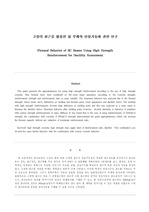

BRONZE
BRONZE 등급의 판매자 자료
고장력 철근을 활용한 휨부재의 연성거동에 관한 연구
2점재하를 실시, 휨강도, 응력 이력곡선, 인장철근 항복시의 처짐량, 파괴시의 처짐량, 균열, 연성지수를 측정하여 변수에 따른 구조적 거동을 분석하였고, 고장력 철근을 적용한 부재는 항복점의 변위가 크게 나타났고, 이러한 특성이 연성지수의 감소를 가져오는 주요 요인으로 밝혀졌다. 그러나 항복이후의 거동은 동일한 강성을 갖는 일반강도철근의 부재와 유사하게 나타났다. 일반적으로 고장력 철근의 적용 시 균형철근비의 감소에 의한 철근비의 증가로 연성거동의 감소효과가 나타나고 있으나, 콘크리트의 강도를 증가시키면 연성의 증대효과를 기대할 수 있다
8 페이지
최초등록일 2012.04.23
최종저작일
2009.08

-
미리보기
소개
2점재하를 실시, 휨강도, 응력 이력곡선, 인장철근 항복시의 처짐량, 파괴시의 처짐량, 균열, 연성지수를 측정하여 변수에 따른 구조적 거동을 분석하였고, 고장력 철근을 적용한 부재는 항복점의 변위가 크게 나타났고, 이러한 특성이 연성지수의 감소를 가져오는 주요 요인으로 밝혀졌다. 그러나 항복이후의 거동은 동일한 강성을 갖는 일반강도철근의 부재와 유사하게 나타났다. 일반적으로 고장력 철근의 적용 시 균형철근비의 감소에 의한 철근비의 증가로 연성거동의 감소효과가 나타나고 있으나, 콘크리트의 강도를 증가시키면 연성의 증대효과를 기대할 수 있다목차
초록,서론,실험,실험결과 및 분석,결론본문내용
Abstract
This paper presents the appropriateness for using high strength reinforcement according to the use of high strength concrete. Nine flexural tests were conducted on full-scale beam specimens according to the concrete strength, reinforcement strength and reinforcement ratio as main variable. The structural behavior was analyzed due to the flexural strength, stress-strain curve, deflections at yielding and fracture point, crack appearance and ductility factor. The member with high-strength reinforcements showed large deflection at yielding point and this was analyzed as a main cause to decrease the ductility factor. Structural behavior after yielding point, however, showed similarity to behavior of members with normal strength reinforcements of same stiffness. It was found that in the case of using reinforcements of 5500㎏f/㎠ strength, the combination with concrete of 800㎏f/㎠ strength demonstrated the great appropriateness which can increase the flexural capacity without any reduction of maximum reinforcement ratio.
Keyword: high-strength concrete, high strength steel, upper limit of reinforcement ratio, ductility This combination also showed the same ductile behavior with the combination with normal concrete behavior.참고자료
· Abstract
· This paper presents the appropriateness for using high strength reinforcement according to the use of high strength concrete. Nine flexural tests were conducted on full-scale beam specimens according to the concrete strength, reinforcement strength and reinforcement ratio as main variable. The structural behavior was analyzed due to the flexural strength, stress-strain curve, deflections at yielding and fracture point, crack appearance and ductility factor. The member with high-strength reinforcements showed large deflection at yielding point and this was analyzed as a main cause to decrease the ductility factor. Structural behavior after yielding point, however, showed similarity to behavior of members with normal strength reinforcements of same stiffness. It was found that in the case of using reinforcements of 5500㎏f/㎠ strength, the combination with concrete of 800㎏f/㎠ strength demonstrated the great appropriateness which can increase the flexural capacity without any reduction of maximum reinforcement ratio.
· Keyword: high-strength concrete, high strength steel, upper limit of reinforcement ratio, ductility This combination also showed the same ductile behavior with the combination with normal concrete behavior.태그
-
자료후기
-
자주묻는질문의 답변을 확인해 주세요

꼭 알아주세요
-
자료의 정보 및 내용의 진실성에 대하여 해피캠퍼스는 보증하지 않으며, 해당 정보 및 게시물 저작권과 기타 법적 책임은 자료 등록자에게 있습니다.
자료 및 게시물 내용의 불법적 이용, 무단 전재∙배포는 금지되어 있습니다.
저작권침해, 명예훼손 등 분쟁 요소 발견 시 고객센터의 저작권침해 신고센터를 이용해 주시기 바랍니다. -
해피캠퍼스는 구매자와 판매자 모두가 만족하는 서비스가 되도록 노력하고 있으며, 아래의 4가지 자료환불 조건을 꼭 확인해주시기 바랍니다.
파일오류 중복자료 저작권 없음 설명과 실제 내용 불일치 파일의 다운로드가 제대로 되지 않거나 파일형식에 맞는 프로그램으로 정상 작동하지 않는 경우 다른 자료와 70% 이상 내용이 일치하는 경우 (중복임을 확인할 수 있는 근거 필요함) 인터넷의 다른 사이트, 연구기관, 학교, 서적 등의 자료를 도용한 경우 자료의 설명과 실제 자료의 내용이 일치하지 않는 경우
문서 초안을 생성해주는 EasyAI
